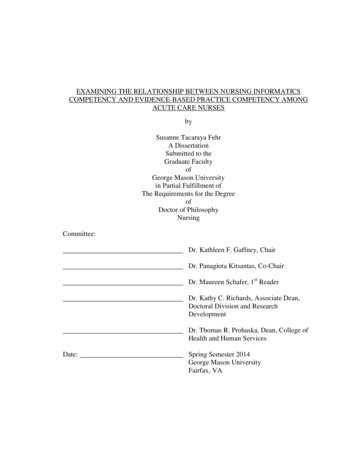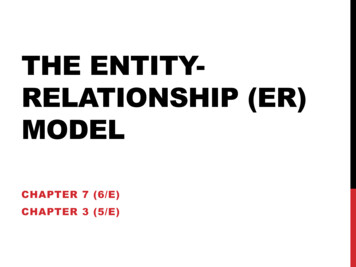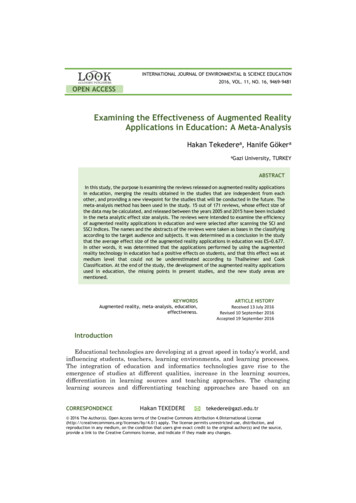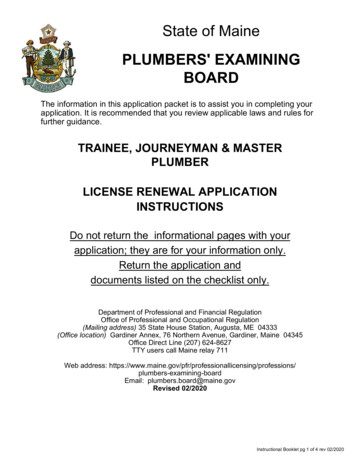
Transcription
EXAMINING THE RELATIONSHIP BETWEEN NURSING INFORMATICSCOMPETENCY AND EVIDENCE-BASED PRACTICE COMPETENCY AMONGACUTE CARE NURSESbySusanne Tacaraya FehrA DissertationSubmitted to theGraduate FacultyofGeorge Mason Universityin Partial Fulfillment ofThe Requirements for the DegreeofDoctor of PhilosophyNursingCommittee:Dr. Kathleen F. Gaffney, ChairDr. Panagiota Kitsantas, Co-ChairDr. Maureen Schafer, 1st ReaderDr. Kathy C. Richards, Associate Dean,Doctoral Division and ResearchDevelopmentDr. Thomas R. Prohaska, Dean, College ofHealth and Human ServicesDate:Spring Semester 2014George Mason UniversityFairfax, VA
Examining the Relationship Between Nursing Informatics Competency and EvidenceBased Practice Competency Among Acute Care NursesA dissertation submitted in partial fulfillment of the requirements for the degree ofDoctor of Philosophy at George Mason UniversitybySusanne Tacaraya FehrMaster of ScienceUniversity of Maryland at Baltimore, 2002Director: Kathleen F. Gaffney, ProfessorSchool of NursingSpring Semester 2014George Mason UniversityFairfax, VA
This work is licensed under a creative commonsattribution-noderivs 3.0 unported license.ii
DEDICATIONTo my parents Josefina and Felix Tacaraya, Mom and Dad, I only hope that I canaccomplish as much as you have in your lifetimes. I am so proud to be your daughter.Thank you for the life and opportunity you have given me.To my awesome husband, Jason, our lives together have always included the PhDprogram. During the PhD program, we were engaged, bought a condo, got married,bought a house, adopted a dog, had a child, adopted another dog I am so excited to seewhat comes next! You and I make a great team. I know I can accomplish anything withyou by my side. I will always be grateful for the love and understanding you have givenme to achieve my goals.To Bernice and John Fehr, you raised a wonderful son whom I love with all of myheart. John, I never met you but I hope you know this doctorate is for you. You have aDr. Fehr in your family. I wish you were here.iii
ACKNOWLEDGMENTSThe writing of this dissertation has been one of the most significant and thoughtprovoking experiences of my life. I was surprised with how much I had learned throughthis process. It is a pleasure to thank all of those people who have helped make thisdissertation possible.First, I wish to thank Dr. Kathleen Gaffney, for all her guidance, support, andpatience. Her ―tough love‖ is what I needed to accomplish this dissertation. Also, I wouldlike to thank my committee members, Dr. Panagiota Kitsantas and Dr. Maureen Schafer,for their encouragement and support. Dr. Schafer, thank you for the hugs!Next, I would like to thank my McLean High School friends (Laura, Shannon,and Ash) for their unconditional understanding of having to miss birthday parties,graduations, baptisms, and reunions. I wish to also thank my James Madison Universitynursing school friends (Aimee, Megan, Lauren, Laura, Holly, Stephanie, Natalie, andMorgen) for still being my friend even though I missed most of the reunions at the skiresorts, beach houses, and other various vacations. Finally, to my University of Marylandfriends (Amy and Kim), who provided consistent encouragement during brunches andconferences, and finally to my George Mason University friends (Patti and Odette) forlistening and giving me expert advice!Also, I would like to thank Dr. Gilad Chen for giving me permission to use theNew General Self-Efficacy Scale, Dr. Sunmoo Yoon for allowing me to use the SelfAssessment Nursing Informatics Scale, and to Dr. Dominic Upton for permission to usethe Evidence-Based Practice Questionnaire.I wish to also thank my neighbors on Pinewood Street, especially Phil and Sheilafor walking my dogs and feeding me during the week. Thank you to Howard, Debbie,Roy, and Corey for reading my dissertation. I am grateful to my coworkers whosupported me, especially Joanne, Robin, Lyn and Mary Ann. Thanks to all the nurseswho took my survey!iv
TABLE OF CONTENTSPageList of Tables . viiList of Figures . viiiList of Abbreviations . ixAbstract . xChapter One: Introduction . 1Background . 1Statement of the Problem . 6Purpose Statement . 9Research Questions . 9Conceptual Underpinning for the Study . 10Conceptual and Operational Definition of Terms . 13Chapter Two: Literature Review . 16Personal and Job-Related Characteristics . 16Age . 16Nursing Degree . 21Years of Nursing Experience . 24Clinical Specialty . 27General Self-Efficacy. 31Studies of the Relationships Between Additional Job-Related Characteristics andNursing Informatics and EBP competencies . 35Nursing Informatics Competency . 37Evidence-Based Practice Competency . 44Summary . 46Chapter Three: Methodology . 47Research Design. 47Setting . 47Population and Sample . 48Study Instruments . 49Instrument Pilot Study . 56Data Collection Procedures. 56Measures . 58Data Analysis . 62Assumptions. 66Multicollinearity . 66Ethical Considerations . 68Summary . 69v
Chapter Four: Results . 70Sample Characteristics . 70Descriptive Statistics of Nursing Informatics and Evidence-Based PracticeCompetencies . 75Cronbach’s Alpha for Scales . 76Overall Differences in Nursing Informatics Competency, Evidence-Based PracticeCompetency, and Self-Efficacy Across Sample Characteristics . 77Objective 1: Relationship Between Nursing Informatics Competency and EBPCompetency . 77Objective 2: How Nursing Informatics Competency and EBP Competency Varyby Personal and Job-Related Characteristics . 78Objective 3: Did Nursing Informatics Competency Predict EBP CompetencyAfter Controlling for Personal and Job-Related Characteristics? . 87Summary of Findings . 89Chapter Five: Discussion . 92Personal and Job-Related Characteristics . 93Age . 93Nursing Degree . 96Years of Nursing Experience . 99Clinical Specialty . 101General Self-Efficacy. 103Shift . 104Currently Magnet . 105Current Position . 106Time Spent on EMR During Shift . 106Nursing Informatics Competency . 107Evidence-Based Practice Competency . 109Limitations . 111Strengths . 113Implications. 114Practice . 114Future Research . 116Policy . 117Education . 117Summary . 118Appendix A. Permission to use Scale . 120Appendix B. Scale . 123Appendix C: IRB Approval . 129References . 131vi
LIST OF TABLESTablePageTable 1: Variable Definitions. 14Table 2: Definitions of Four Levels of Practicing Nurses in Informatics. 38Table 3: Study Instruments, Subscales, and Psychometric Properties . 55Table 4: Research Questions, Variables, and Statistical Tests . 68Table 5: Description of Sample Characteristics. 74Table 6: Descriptive Statistics of Nursing Informatics amd Evidence-Based PracticeCompetencies . 76Table 7: Cronbach's Alpha for Nursing Informatics Competency and Evidence-BasedPractice Competency Subscales . 77Table 8: Correlation Matrix for Continuous Variables . 78Table 9: Assessing Differences in Nursing Informatics, Evidence-Based Practice andSelf-Efficacy by Sample Characteristics . 85Table 10: Multiple Regression Analyses . 88vii
LIST OF FIGURESFigurePage1. Proposed Conceptual Model of Nursing Informatics Competency and EvidenceBased Practice Competency adapted from Staggers, Gassert, and Curran’s (2002)Information Management Framework. . 11viii
LIST OF ABBREVIATIONSAmerican Nurses Association . ANAAmerican Recovery and Reinvestment Act . ARRAAssociation of Women’s Health, Obstetrics and Neonatal Nursing . AWHONNAdvancing Research and Clinical Practice through Close Collaboration . ARCCBachelor’s of Science in Nursing . BSNCaring Efficacy Scale . CESDepartment of Health and Human Services. DHHSDoctor of Nursing Practice .DNPElectronic Medical Records . EMREvidence-Based Practice . EBPEvidence-Based Medicine . EBMEvidence-Based Nursing .EBNEBP Self-Efficacy Scale .EBPSEEvidence-Based Practice Questionnaire . EBPQGeneral Self-Efficacy Scale . GSESGeorge Mason University . GMUHealth Information Technology. HITInformation Technology . ITInstitute of Medicine . IOMInstitutional Review Board . IRBMaster’s of Science in Nursing . MSNNurses’ Attitudes Toward Computers Questionnaire . NATCNurses’ Computer Attitudes Inventory . NCATTNew General Self-Efficacy Scale . NGSERegistered Nurse . RNOutcome Expectancy for EBP .OE-EBPOperating Room . ORSelf-Assessment of Nursing Informatics Competencies Scale . SANICSSelf-Efficacy in EBP . SE-EBPSherer et al.’s General Self-Efficacy Scale . SGSEStaggers Nursing Computer Experience Questionnaire . SNCEQTechnology Informatics Guiding Education Reform . TIGERQuality and Safety Education for Nurses . QSENUnited Kingdom. UKUnited States . U.S.Women’s and Children’s . W&Cix
ABSTRACTEXAMINING THE RELATIONSHIP BETWEEN NURSING INFORMATICSCOMPETENCY AND EVIDENCE-BASED PRACTICE COMPETENCY AMONGACUTE CARE NURSESSusanne Tacaraya Fehr, Ph.D.George Mason University, 2014Dissertation Director: Dr. Kathleen F. GaffneyIn 2003, the Institute of Medicine (IOM) released a report entitled HealthProfessions Education: A Bridge to Quality, which recommended that every nurse beeducated to deliver patient-centered care as part of an interdisciplinary team, emphasizingevidence-based practice, quality improvement approaches, and informatics. Evidencebased practices (EBP) represent an efficient and cost-effective infrastructure for ensuringquality of care and improving patient outcomes. Many healthcare information technologyapplications are incorporating computerized decision-support systems that have beendeveloped from EBP. Nurses, the largest group of healthcare providers, need to developinformatics competency in order to effectively translate and use or implement EBP.Nurses increasingly require information technology competency to effectively practice inthe current healthcare environment. Nursing informatics competencies are a worldwidenecessity for the acute care nurse. Yet, there is limited research on the relationshipx
between nursing informatics competency and evidence-based practice competency, twoseparate yet related competencies that are recommended by the IOM for all nurses.The purpose of this research study was to examine the relationship betweennursing informatics competency and evidence-based practice competency and to assesshow these competencies may vary by personal and job-related characteristics amongacute care nurses. Data were collected in a multihospital system using three establishedsurveys measuring general self-efficacy, nursing informatics competency, and evidencebased practice competency. The convenience sample included 197 acute care nurses whoparticipated in a voluntary study in January 2014 at a multihospital system in Virginia.This study used descriptive statistics, bivariate correlation, and multiple regression toanalyze the data.The findings from this study reveal that nursing informatics competency is relatedto EBP competency (r . 548, p .01). There was also a weak but statistically significantcorrelation with self-efficacy and EBP competency (r .248, p .01). Furthermore,nursing informatics competency predicted EBP competency, by accounting for 30% ofthe variance. This research also offered a starting point to determine acute care nurses’self-reported informatics and EBP competencies. Study findings may inform the designof interventions to enhance nursing informatics competency and EBP competency amongacute care nurses.xi
CHAPTER ONE: INTRODUCTIONBackgroundThe Institute of Medicine (IOM) released a report, Health Professions Education: ABridge to Quality 11 years ago, which recommended that ―all health professionals shouldbe educated to deliver patient-centered care as members of an interdisciplinary team,emphasizing evidence-based practice, quality improvement approaches, and informatics‖(2003, p. 45). Thus the nursing profession must prepare its members to effectively useinformatics skills involving computers, information, and informatics literacy (Hart, 2008)and implement evidenced-based practice (EBP).EBP is a problem-solving approach to the delivery of care that incorporates the bestavailable scientific evidence from well-designed studies in combination with a clinician’sexpertise and patients’ preferences within a context of caring (Fineout-Overholt, Levin, &Melnyk, 2004). Informatics is the combination of information science, computer science,and disciplinary-specific science (Buerck & Feig, 2006). The American Nurses Association(ANA) defines nursing informatics as a specialty that integrates nursing science, computerscience, and information science to manage and communicate data, information,knowledge, and wisdom in nursing practice (2008).Informatics competencies are among the essential components of an infrastructurethat supports evidence-based practice. A clinician with an understanding of informatics1
gains knowledge concerning the possibilities and limitations of systematically processingdata, information, and knowledge. Informatics competencies also support buildingevidence—from clinical practice to research protocols—as well as retrieving and applyingevidence to practice (Curran, 2003). Using informatics reduces variation in practice andhelps prevents errors, as clinicians learn that mastering the information and knowledgeneeded to make informed decisions is essential (Curran, 2003).Eleven years later, as the United States (U.S.) seeks to restructure healthcare toimprove quality and safety, and to bridge the gap between evidence and practice,information technology (IT) is one process to enhance information access and supportdecision making (Doebbeling, Chou, & Tierney, 2006; McBride, Delaney, & Tietze, 2012).Additionally, IT may help meet other objectives such as delivering EBP (Doebbeling et al.,2006). This includes an integrated repository of the patients’ demographic and medicalhistory with efficient access to information supporting patients and providers in sharedhealthcare decisions (Doebbeling et al., 2006). The informatics infrastructure needed forEBP includes data acquisition methods, as well as healthcare data standards, standardizedterminology, data repositories, rule repositories, clinical event monitors, data-miningtechniques, digital sources of evidence, and communication technologies (Bakken, Cimino,& Hripcsak, 2004; Doebbeling et al., 2006).Informatics is still an emerging science in healthcare (Hwang & Park, 2011), andhas become a mandate for nursing practice. In 1994, the ANA published its Scope ofNursing Informatics Practice and the Standard of Nursing Informatics Practice (Ozbolt &Saba, 2008). One year later, the American Nurse Credentialing Center established2
certification in nursing informatics as an area of specialty practice (Ozbolt & Saba, 2008).In 2001, a research-based list of informatics competencies for nurses was created byStaggers, Gassert, and Curran. The following year, Staggers et al. (2002) developed fourlevels of nursing informatics practice ranging from beginning nurses to informaticsinnovators. The increased use of informatics can be attributed to government regulationsand standards as well as increased importance placed on informatics within the healthcareindustry.The United States government stressed the importance of information technology in2009 when President Barrack Obama signed the American Recovery and Reinvestment Act(ARRA) into law, which invested 48.8 billion in Health Information Technology (HIT)(U.S. Department of Health and Human Services [DHHS], 2009). The Obamaadministration and healthcare experts believe that electronic information systems are vitalto improving the health and healthcare of Americans (Blumenthal, 2009). In a major speechon January 8, 2009, President Obama stated, ―To improve the quality of healthcare whilelowering its costs, we will make the immediate investments necessary to ensure that withinfive years, all of America’s medical records are computerized.‖IOM’s 2003 report endorsed the development of five competencies for allhealthcare providers: to provide patient-centered care, to work in interdisciplinary teams, touse evidence-based practice, to apply quality improvement, and to use informatics (Flood,Gasiewicz, & Delpier, 2010). To address the gap in teaching nursing informatics acrossnursing programs, the National League for Nursing (2008) and the American Associationof Colleges of Nursing (2008) advocated to include informatics and EBP in nursing3
programs. In 2007, only 38% of nursing programs taught informatics, and studentachievement related to informatics ranked lowest among the Quality and Safety Educationfor Nurses (QSEN) competencies (Smith, Cronenwett, & Sherwood, 2007). Smith et al.’ssurvey results revealed deficiencies and provided nursing programs with insight into areaswith opportunities for improvement, especially in informatics and EBP.In 2012, researchers reviewed the top online nursing schools from the U.S. Newsand World Report list for informatics courses offered in each program (Hunter, McGonigle,& Hebda, 2013). The findings revealed that among the 24 schools reviewed, 6 had noinformatics content in any level. The websites of the other 18 top schools listed informaticscontent for 10 at the baccalaureate level, 9 at the master’s level, and 4 at the doctoral level.Only 1 school had content in all three levels. Furthermore, only 4 schools offered a focuson nursing informatics. The researchers also found diverse titles given to the informaticstype courses, which implied possible variations in course content (Hunter et al., 2013). Thechallenge for academic nursing programs is to standardize the structure and delivery ofinformatics courses across their curricula as well as collaborate with universities that offera more robust program of study in this area.EBP has been a commonly used term in the past few years to describe practicebased upon the best research evidence. Sometimes EBP has been interchangeable withevidence-based medicine (EBM), and in nursing it may be referred to as evidence-basednursing (EBN). EBP is the conscientious use of the best current evidence in makingdecisions about patient care (Straus, Glasziou, Richardson, & Haynes, 2011). The EBPprocess has seven steps: cultivating a spirit of inquiry; asking the clinical question;4
collecting the most relevant and best evidence; critically appraising the evidence;integrating all the evidence with one’s own clinical expertise, patient preference, andvalues in making a practice decision or change; evaluating the practice decision or change;and disseminating the outcomes of the EBP decision or change (Melnyk & FineoutOverholt, 2011).EBP requires making decisions about how to provide care at a time when patientsand families are becoming more informed about their healthcare decisions. The publicationof patient care standards and outcomes have made healthcare a competitive market as well.Some patients and families are choosing where to receive healthcare according to outcomesand patient satisfaction (Ellerbe & Regen, 2012), creating an impetus to incorporateevidence into healthcare practice, specifically in nursing, since nursing provides a largeportion of patient care—especially in acute care settings. However, EBP has not beenadopted as a universal solution and has only been implemented sporadically (Melnyk &Fineout-Overholt, 2011). In areas where tradition and evidence do not agree, nursingpractice continues to follow tradition (Makic, Martin, Burns, Philbrick, & Rauen, 2013).An example in the adult acute care setting is the use of large-bore intravenous catheters forblood administration (Makic et al., 2013). It is believed that small-bore catheters result inslower infusion rates and cell hemolysis during blood administration. However, theevidence shows that in nonurgent blood administration, small-bore catheters can be usedwithout hemolysis (Makic et al., 2013). One solution is to maximize technology to improveclinical and administrative processes and enhance delivery of
Examining the Relationship Between Nursing Informatics Competency and Evidence-Based Practice Competency Among Acute Care Nurses A dissertation submitted in partial fulfillment of the requirements for the degree of Doctor of Philosophy at George Mason University by Susanne Tacaraya Fehr Master of Science University of Maryland at Baltimore, 2002










